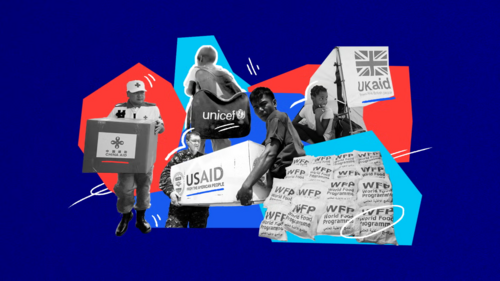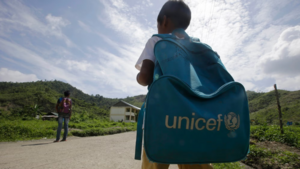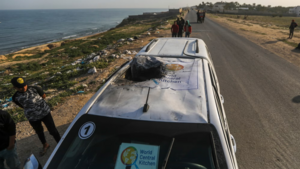Why Are There Logos on Foreign Aid?

As organizations fight for funding and countries vie for international clout, the “soft power” move behind branded aid is beginning to show.
In short: From tents to toilets to bags of food, there’s one thing much of humanitarian aid has in common: logos. The logos emblazoned on aid products often have practical purposes, including alerting a receiver to the legitimacy of the aid package, ensuring aid workers are easily recognizable in conflict zones, and even demonstrating an organization’s – or country’s – on-the-ground commitment in a crisis. But as organizations fight for funding and countries vie for international clout, the “soft power” move behind branded aid is beginning to show – and one NGO is over it.
Branding on U.S.-funded humanitarian aid dates back at least as far as 1961. That year, President John F. Kennedy created the United States Agency for International Development – the body responsible for administering aid on behalf of the government, known commonly as USAID – and introduced the Foreign Assistance Act, which established rules for how humanitarian aid would be delivered.
One of the act’s provisions was a marking requirement, stipulating that all aid products funded under the law must be branded as “American Aid.” Some USAID packages would even require the label “from the American people” – a motto that’s become much more common in the agency’s branding over the decades.

USAID humanitarian aid at a warehouse at the Tienditas International Bridge on the outskirts of Cucuta, Colombia, Thursday, Feb. 21, 2019.
What is “Soft Power,” and How Does Branded Aid Contribute to It?
Coined by political scientist Joseph Nye Jr. in the 1980s, the term “soft power” represents a nation’s capacity “to influence others without resorting to coercive pressure.”
One recognizable example of soft power is the Peace Corps, which was created during the Cold War “to win hearts and minds” in developing countries that hadn’t allied themselves with Russia or the U.S.
Foreign aid is another common soft power tool, especially when it features prominent branding that identifies the donor country. Through aid, governments send money, goods, and services to other countries to advance their interests, foster goodwill and strengthen partnerships.
After 9/11, the U.S. began to consider foreign aid a key part of its national security strategy. While there was a clear humanitarian reason to provide increased assistance to anti-terrorism efforts, there was also an underlying motivation: If the U.S. gave countries aid, then the hope was that the U.S. would be viewed more positively. For example, in 2004, USAID sent $400 million to Indonesia after an earthquake and tsunami hit the country. The Pew Research Center largely credited this act with doubling the U.S.’s favorability in the country six months after the event.
The U.S. isn’t alone in these types of efforts, though. For many of the most powerful countries in the world, branded aid can be a way to make their country more liked, as it demonstrates their global engagement and leadership in the developing or conflict-stricken nations that receive the aid.
China has given significant amounts of money to Africa in the form of grants and loans, providing African countries with $160 billion in loans between 2000 and 2020. In turn, many Africans held a largely positive view of China’s influence on the continent until China refused to suspend loan payments amid the COVID-19 pandemic.
Visibility is another factor at play with branded aid, since prominent branding can help organizations like UNICEF generate more donations in a highly competitive funding landscape.
“When agencies post these logos on toilets, schools, objects, it's very much about gaining visibility to donor audiences through the international media," University of Sheffield lecturer Dmitry Chernobrov told NPR in 2018.

A student walks to school with a UNICEF backpack in Tacloban, Leyte province in central Philippines, Wednesday, Nov. 5, 2014.
Why Are Some Organizations Moving Away from Branded Aid?
While logos can help organizations generate donations in a competitive environment, Norwegian Refugee Council head Jan Egeland said they have created a visibility “arms race,” leading to a “carnival of names and flags and logos” on everything from tents to toilets.
Branded aid can also erode citizens’ trust in their own governments, which often work with the aid groups to deliver supplies. The exclusive display of external countries’ or organizations’ logos can potentially undermine and delegitimize local government efforts, writes W. Gyude Moore, former Liberian public works minister.
In a 2023 interview with the New Humanitarian, Egeland said branding can also be harmful to aid recipients, since it risks making them unwitting, walking advertisements for aid groups.
That last sentiment, though, isn’t universal. In 2018, for instance, NPR spoke with Cedric Habiyaremye, a Rwandan scientist who lived in a Tanzanian refugee settlement as a child. (Habiyaremye was also affiliated with the Chicago Council on Global Affairs as a Next Generation Delegate for the Global Food Security Symposium.)
He told NPR that seeing the logo for the World Food Programme on aid trucks coming into the camp was “a very reassuring time of day.”
"No one complained that the logos were demeaning or humiliating," Habiyaremye said. "I feel that I am glad I got to know who served me at the refugee camp."

Vehicle with the World Central Kitchen logo wrecked by an Israeli airstrike in Deir al Balah, Gaza Strip, Tuesday, April 2, 2024.
Could Global Aid Go Generic?
In April 2024, the NRC announced that they would be working to significantly reduce the use of logos on aid supplies and infrastructure.
“In the ideal world,” said Egeland, “I would see us branding our own structures – I mean a warehouse, the office, our vehicles – so that you know who we are and where we go,” but not always branding the aid products themselves.
There are numerous factors, though, that could prevent the NRC and other organizations from achieving brandless aid. The main issue: “visibility” is required in many aid project contracts, including those overseen by the EU and, thanks to the Foreign Assistance Act, those run by USAID. Until such requirements are lifted, generic aid could have trouble gaining ground.



